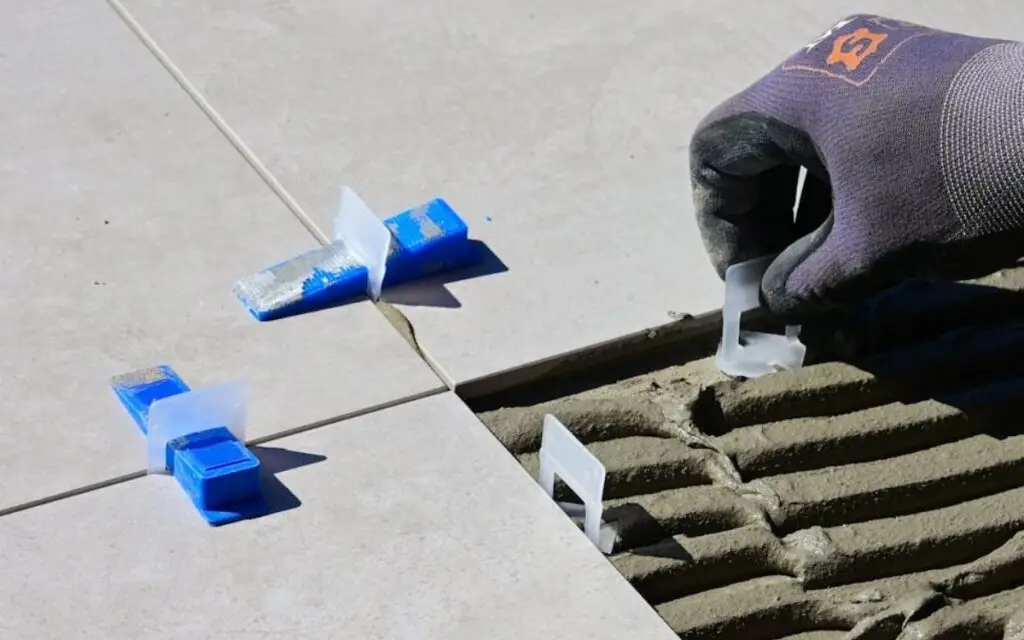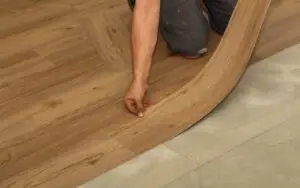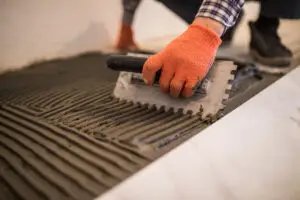Understanding the Basics of Tile Adhesive
Why Accurate Adhesive Calculation is Crucial
Accurately calculating the amount of tile adhesive needed is essential for a successful tile installation. Using too little adhesive can result in tiles not adhering properly, leading to loose tiles, cracks, and the need for costly repairs. Using too much adhesive can result in an uneven surface, tiles slipping out of place, and a waste of product. Proper calculation ensures a seamless installation, saves you money, and guarantees the longevity of your tiled surfaces. This is one of the main reasons why professional installers are highly recommended for this job.
Types of Tile Adhesive and Their Uses
There are different types of tile adhesive, each designed for specific types of tiles and substrates. Thin-set mortar is often used for most ceramic and porcelain tiles, while epoxy-based adhesives are more durable and suitable for more demanding installations, like heavy stone tiles and areas with high humidity. Selecting the right adhesive is crucial for a successful project, and a professional installer will be knowledgeable about the best option for each situation.
Key Factors Affecting Tile Adhesive Needs
Tile Size and Thickness
The size and thickness of your tiles will greatly affect how much adhesive you will need. Larger tiles require more adhesive to ensure proper coverage, while smaller tiles will require less. Additionally, thicker tiles need more adhesive to ensure a strong bond with the substrate. Professional tile installers are experts in estimating the correct amount of adhesive to use, which will guarantee a smooth installation.
Small vs. Large Format Tiles
Small format tiles typically need less adhesive because they have a smaller surface area. Larger format tiles, on the other hand, require a thicker layer of adhesive to ensure adequate support. This difference is something a professional is well aware of, which makes them an asset for this type of job.
Substrate Type and Condition
The type and condition of the surface you’re tiling on, called the substrate, will also influence the amount of adhesive required. For example, a smooth, level concrete substrate will need less adhesive compared to an uneven or porous substrate like wood. Preparing the substrate is also essential for adhesion, and any moisture, debris, or unevenness can affect the bond between the adhesive and the surface, so this is another step that is best performed by a professional.
Concrete, Wood, and Existing Tile
Concrete is generally a stable surface, but it should be checked for cracks and unevenness before tiling. Wood is more prone to movement and requires a more flexible adhesive. When tiling over existing tile, you may need a specialized adhesive designed for this specific purpose. Knowing which adhesive to use for each situation will guarantee a long lasting result, which is why professional advice is always important.
Trowel Size and Notch Type
The trowel you use to apply tile adhesive plays an important role in controlling how much adhesive is used. The trowel’s notch size and type will affect the thickness of the adhesive layer, and choosing the correct size is essential for ensuring the proper coverage. Professionals are aware of these details, which is why it is always better to hire an experienced installer for any tiling project.
Square-Notch vs. V-Notch Trowels
Square-notch trowels are good for applying thicker layers of adhesive, making them ideal for large or uneven tiles. V-notch trowels apply thinner layers, which is ideal for smaller tiles or when using self-leveling compounds. Knowing which trowel is best for each job is another reason why professionals are always recommended.
Calculating Tile Adhesive: A Step-by-Step Guide
Measure the Area to Be Tiled
The first step is to accurately measure the area you plan to tile. Measure the length and width of each surface and multiply these figures to determine the square footage. If the area is not a perfect rectangle or square, break it into smaller sections, measure them individually, and add the figures together to calculate the total area. Precise measurements ensure you buy the correct amount of materials and that there is no waste. Professionals are meticulous when measuring, which guarantees that you don’t over or under buy adhesive.
Calculating Square Footage
Calculating the square footage involves multiplying the length of the area by the width. For example, if a floor is 10 feet long and 8 feet wide, the area is 80 square feet. Always double-check your measurements to avoid costly errors, and if you are not confident in your math, hiring a professional will ensure a correct measurement, saving you money in the long run.
Determine the Required Adhesive Thickness
The required thickness of the adhesive layer will depend on the tile size, type, and the manufacturer’s recommendations. Usually, the thickness will range between 1/8 inch to 1/4 inch. Professionals are knowledgeable about manufacturer recommendations and always use these guidelines to make sure the project is correctly done.
Using Manufacturer Guidelines
Manufacturer guidelines are the best way to ensure you use the correct adhesive thickness for your project, as each product might vary slightly. Always refer to the manufacturer’s recommendations or contact them directly for specific information. Professionals always follow the manufacturer’s guidelines to ensure a quality result.
Calculate the Total Volume of Adhesive Needed
With the area and the thickness figured out, you can calculate the total volume of adhesive you will need, accounting for waste, overlaps, and any additional areas that might require a little more adhesive. Usually, you should account for 10-15% extra material, to make sure you don’t run short. This process requires some expertise and practice, which is another advantage of hiring a professional installer.
Accounting for Waste and Overlap
Accounting for waste and overlap is essential to prevent running out of adhesive mid-project. A general rule is to add 10-15% more material to compensate for any minor mistakes. Also, it is wise to buy a little extra adhesive just in case, so you will always have some on hand for any eventualities. Professionals are very precise and can estimate the correct amount of waste to expect, which reduces the extra amount you will need to buy.
Tools and Materials for Tile Installation
Essential Tools for Tile Setting
Essential tools for tile setting include the trowel, spacers, a level, a measuring tape, and a grout float. These tools are all necessary to ensure the job is done precisely and professionally. Professionals always have the right tools to ensure a smooth installation process, and they are also familiar with using them.
Trowels, Spacers, Level, and Grout Float
Trowels come in different sizes and notch types, each suited to different tasks, so it is important to choose the correct one. Spacers ensure consistent grout lines, and levels are used to keep the tiles even. A grout float is used to apply grout evenly. Professional tile installers have a range of trowels and spacers for any job, making sure all bases are covered.
Preparing and Mixing Tile Adhesive
Preparing the adhesive requires mixing it with water or a liquid polymer, following the manufacturer’s instructions, in order to get the right consistency. The consistency of the adhesive should be smooth and easy to spread but also thick enough to hold the tiles in place. Professional installers know how to achieve the correct consistency, and this skill is vital to the final result.
Achieving the Right Consistency
Achieving the right consistency for the tile adhesive requires precision and some experience. Too much water can make it too thin, while not enough water makes it too hard to work with. Professional tile installers know how to mix the adhesive perfectly, making sure it is easy to work with but also that it can adhere the tiles properly.
Safety Precautions During Installation
Safety is paramount when working with tile adhesive. It is essential to wear protective gear, such as gloves and safety goggles, and work in a well-ventilated area. Some adhesives contain chemicals that can irritate the skin and eyes. Professionals always prioritize safety, and they are well equipped to work with all the necessary safety measures in place.
Protecting Yourself from Chemical Exposure
When working with tile adhesive, it is crucial to protect yourself from chemical exposure. Wearing gloves and safety glasses will prevent skin and eye irritations, while having proper ventilation will avoid respiratory issues. Professionals are always aware of safety and will take the necessary steps to make sure the workplace is safe for everyone.
Professional Tile Installation vs. DIY
Case Study 1: Costly Mistakes in DIY Tile Projects
A homeowner attempted a DIY tile installation, underestimating the amount of adhesive needed. They ran out of adhesive halfway through the project and then had to rush to the store to buy more. They ended up applying too much adhesive, which caused the tiles to slip, creating an uneven surface. Eventually, the homeowner hired a professional to redo the entire project, spending more than double the amount they would have spent if they had hired a professional from the beginning.
Case Study 2: Benefits of Hiring Professional Tile Installers
A homeowner decided to hire a professional for her bathroom tile installation. The installer provided a detailed quote that included all materials and labor, and they also provided advice on the best adhesive to use for her specific tiles and substrate. They completed the job quickly and efficiently, and she was very pleased with the result.
Risks of Improper Adhesive Application
Improper adhesive application can lead to several problems with tile installation, such as tiles not adhering correctly, uneven surfaces, and eventual cracks and damages to the tiles. These problems can cause the tiles to be replaced, which adds extra costs to the project. Hiring a professional reduces these risks and guarantees the job is done correctly.
Long-Term Cost Savings of Professional Tiling
While DIY might seem like a less expensive solution, it can end up costing more money in the long run due to potential errors. Professional tile installation not only guarantees a great result but also protects your investment, as all work is usually guaranteed, saving you money in the long term.
Ensuring Proper Adhesion and Installation
Applying the Adhesive Correctly
Applying adhesive correctly involves using the right trowel size and type, applying consistent pressure, and ensuring that all areas are properly covered. This process is vital for tile adhesion, and professional tile installers are trained to do this correctly, ensuring a smooth installation that will last for years to come.
Setting Tiles with Precision and Care
Setting tiles with precision and care requires an eye for detail and a steady hand. The tiles must be placed evenly, with consistent grout lines, and they must also be aligned with the rest of the surface. Professionals have all these skills and techniques that they have gained from years of experience, making them the best choice for a flawless tiling job.
Curing Time and Next Steps
After tile setting, the adhesive needs time to cure before any other work can be done. The curing time varies according to the adhesive type, and following the manufacturer’s guidelines is crucial for ensuring a stable and lasting result. Professional installers are well aware of this and will always follow the manufacturer’s recommendations to ensure no issues arise.
Maintenance and Long-Term Care
Proper maintenance and long-term care is essential for ensuring your tiles look beautiful for many years to come. Professionals can also offer great advice on how to best take care of your tiles, and this advice is very important to extend the life of your tiled surfaces.
FAQs & Answers
No, not all tile adhesives are created equal, and using the wrong type for your specific tile and substrate can lead to installation failures. Each adhesive is designed for different materials and setting conditions. Professional tile installers are knowledgeable about the various types of adhesives and can recommend the right one for your project, ensuring a long-lasting and secure installation that will save you time and money. Moreover, this will prevent any possible issues in the future that might arise because of an incorrect application.
The trowel size is critical for applying the correct amount of adhesive. Using the wrong trowel can result in insufficient adhesive coverage, which means the tiles won’t adhere properly. It can also result in excess adhesive, which will cause a mess, delay your installation, and end up being a waste of product. Professional installers are aware of this and use the correct trowel size to ensure the proper adhesion and a smooth, even installation, which is why it is highly recommended you hire a professional for the job.
Using too much adhesive can result in tiles slipping out of place or creating an uneven surface, while too little adhesive might not provide adequate bonding. This could lead to tiles becoming loose or cracked. Applying the right amount of adhesive requires expertise and a correct trowel size, which is something professional installers are aware of. Hiring a professional tile installer ensures the adhesive is applied correctly, avoiding costly and time-consuming mistakes that could compromise the quality of the entire project.
Yes, proper surface preparation is fundamental for successful tile installation. The surface must be clean, level, and free of any contaminants that could hinder adhesion. Failing to prepare the surface correctly can lead to tiles not adhering properly or cracking over time. Professional tile installers take the time to properly prepare the surface, using specific techniques that guarantee a secure and long-lasting installation. This will not only make the tiles look better but also extend their durability.
While DIY tile installation might seem like a cost-saving option, it requires specific skills, experience, and tools to ensure a quality, durable, and even installation. Professional tile installers are aware of all aspects of the process, from the correct adhesive choice to trowel sizing and precise tile setting. This experience leads to a superior result, reduces installation time, and minimizes the risks of costly mistakes. Hiring a professional not only saves you time and stress, but also ensures that the job is done correctly the first time, and it provides a long-lasting result with a great aesthetic.





